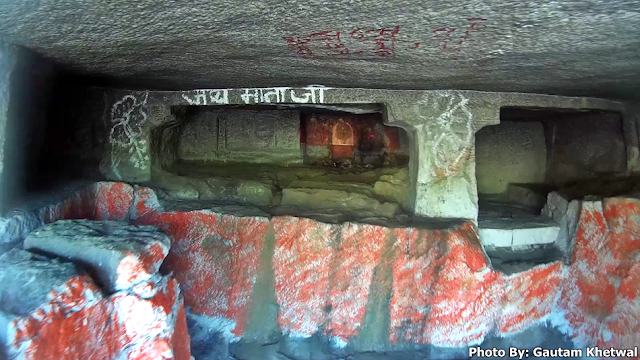Malanggad also known as Haji Malang is a 700+ meter tall mountain near Kalyan City of Maharashtra. Malanggad lies in Matheran mountain range and separated from the main range by a khind and is a type of isolated hill jointed to another much taller mountain Tavli through a khind. Malanggad is distinct by its three pinnacle structure and is visible from any where during clear weather. Malanggad is a type of basaltic hill with three levels. Malanggad trek is an easy trek till Sone Machi and a crowded one.
1) Pir machi (where the Haji Malang Dargah is located.) 500m asl.
2) Sone Machi (the second plateau after the steep steps climb) 600m asl.
3) Balekilla (Saat Bawdi - the top most part after the pipes) 700m asl.
To reach Haji Malang one has to climb many steps through many shops and houses from bus stop. The base is the bus stop of Malanggad bus no 45.
Malanggad has a huge history as the Ketkars were the Killedars. The fort was built in 7th Century by King Nalanda. Brief battle was fought between Marathas and British on Malanggad. Malanggad is a type of fort in which there are no windows to fire or protective walls. It sole depends upon its sheer walls for protection from invaders. This made the Britishers hard to capture and led to siege of the fort. Firing proved no use for them from Pir Machi. Another route is from Vavanje village where in a brief battle was fought. The structure of Malanggad is very strong. The last pinnacle is known as Devni or Bara Ansaar pinnacle.
Pir Machi is laden with shops and is a very big plateau and the far end is Panch Pir where there are graves of Disciples of Baba Malang while second step is Sone Machi which is 250m long and narrow and has 3 bastion and a Chor darwaja with many water cisterns. Also Malanggad is infested with monkeys.
On the east side of Malanggad is a temple of Datta Mandir and a deep well and further Ganesh mandir in deep woods. One can also trek to Tavli or Dadi Maa where the main Dargah is located which is opposite mountain. It takes around 4 to 5 hours to Dadi Maa through forests. Tavli is second highest mountain in Matheran range after Matheran.
To reach the top one has to cross 15 feet pipes which are placed where the steps have been blown off. A person used to set ropes and charged some fee to cross but as on date by locals on Oct 2017 the person has stopped the service due to order by police due to some accident on pipes. The pipes have gone loose and harness removed. On top there are seven water cisterns (saat bawdi) which feeds water to Haji Malang through pipes and a dilapidated structure used to store grains and ammunition.
Malanggad has many temples and mosques on the way to Haji Malang. A Funicular railway is also being built to avoid climbing many steps which will gain 340m height on rails.
During Urs festivals the palki of Baba is taken on round around whole mountain and celebrated with pomp. The mountain is lit with lights and a sight worth watching.
How to Reach:
Bus No 45 of Malanggad straight to base from Kalyan Railway Station - Rs 20 / person.
Pir Machi is laden with shops and is a very big plateau and the far end is Panch Pir where there are graves of Disciples of Baba Malang while second step is Sone Machi which is 250m long and narrow and has 3 bastion and a Chor darwaja with many water cisterns. Also Malanggad is infested with monkeys.
On the east side of Malanggad is a temple of Datta Mandir and a deep well and further Ganesh mandir in deep woods. One can also trek to Tavli or Dadi Maa where the main Dargah is located which is opposite mountain. It takes around 4 to 5 hours to Dadi Maa through forests. Tavli is second highest mountain in Matheran range after Matheran.
To reach the top one has to cross 15 feet pipes which are placed where the steps have been blown off. A person used to set ropes and charged some fee to cross but as on date by locals on Oct 2017 the person has stopped the service due to order by police due to some accident on pipes. The pipes have gone loose and harness removed. On top there are seven water cisterns (saat bawdi) which feeds water to Haji Malang through pipes and a dilapidated structure used to store grains and ammunition.
Malanggad has many temples and mosques on the way to Haji Malang. A Funicular railway is also being built to avoid climbing many steps which will gain 340m height on rails.
During Urs festivals the palki of Baba is taken on round around whole mountain and celebrated with pomp. The mountain is lit with lights and a sight worth watching.
How to Reach:
Bus No 45 of Malanggad straight to base from Kalyan Railway Station - Rs 20 / person.































































